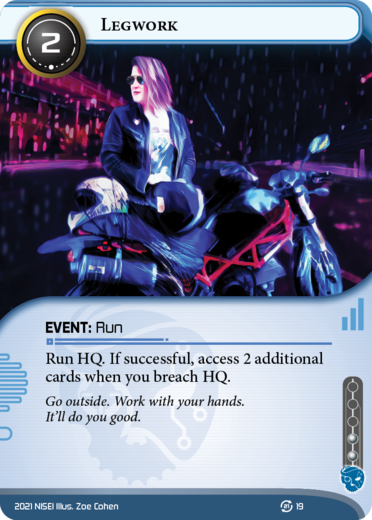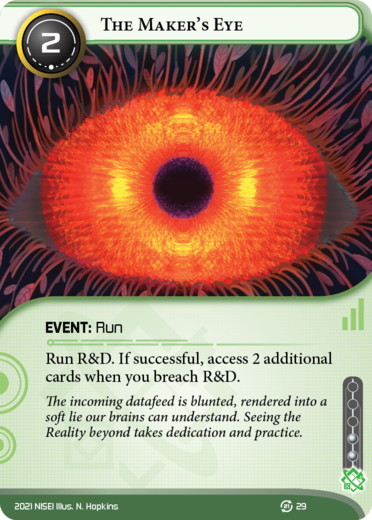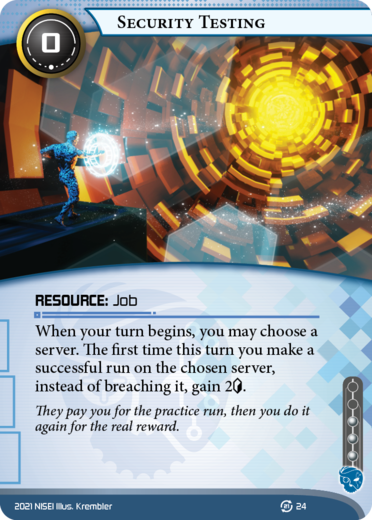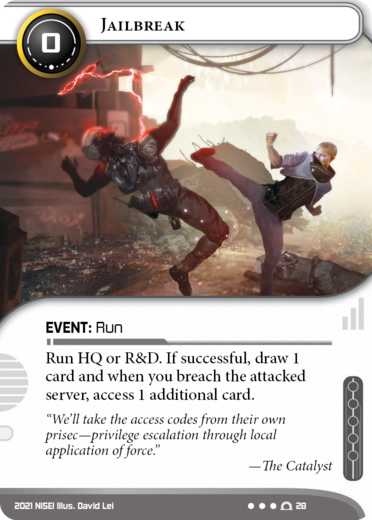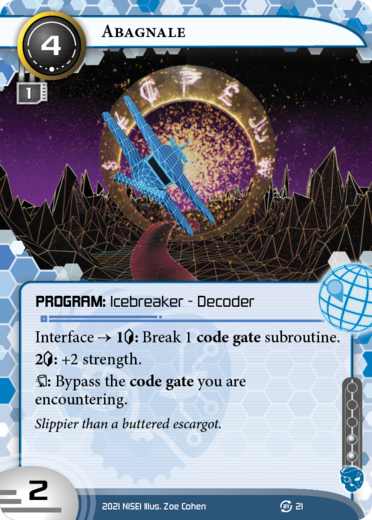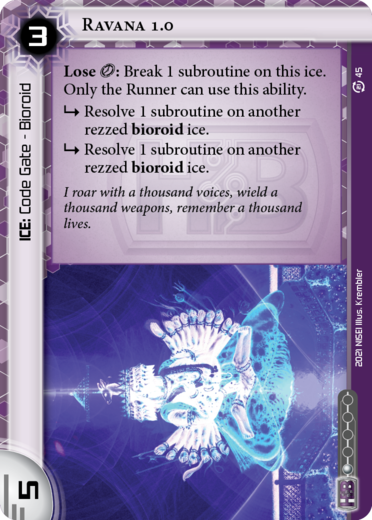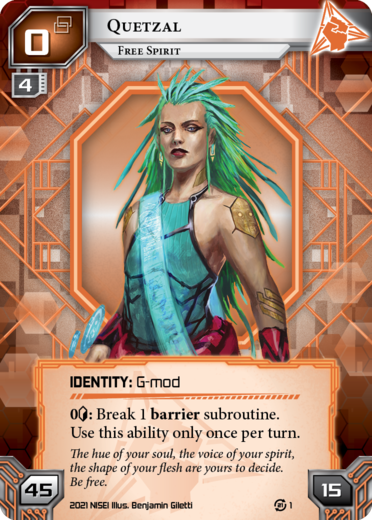Hello everyone! I’m Justin (aka Cephalopod Wizard) from the Rules team. It’s possible that you’ve seen me on Jinteki.net testing ambitious decks, such as my long-running dream of putting Dedicated Processor on Musaazi. I’m here to tell you about the latest round of changes to how we write card text, as we continue our work to make the rules clearer and more consistent. To show what we’ve been working on, I’ve got a few cards for you from System Update 2021, and one from System Gateway.
Breaching the Topic
Our first update is to make clear what is being given up when you use access replacement effects, as well as whether certain triggers fire or not. Consider Aumakua:
Whenever you expose a card or access cards and do not steal or trash any of them, place 1 virus counter on Aumakua.
If you run an empty Archives, do you get a virus counter? Reasoning this out via the English language, you could argue: “No. I did not access any cards, because there were no cards in Archives.” You could also argue: “Yes. I accessed a set of cards, even if there were zero cards in that set.” Ideally, we could easily figure this out without having to ask someone.
To clarify this, we have a new keyword: breach. Breach is equivalent to the phrase “access cards” seen on currently printed cards, and it should allow us to disambiguate between “accessing cards” (the general step of a successful run) and “access a card” (the specific action). Now a successful run on a server looks like this:
- Having passed all ice defending a server, the Runner declines to jack out
- Paid ability window
- Run is declared successful
- The Runner breaches the server, accessing cards in a way appropriate to that server. For example, accessing a random card from HQ and all upgrades in the root of HQ.
Some ways we might use breach in a sentence include:
- “Run HQ. If successful, instead of breaching HQ, do Criminal things.”
- “Whenever you expose a card or breach a server and do not steal or trash any cards, place 1 virus counter on this program.”
With all that in mind, here’s a few System Update 2021 cards using the new terminology!
And here’s a new card that hasn’t been seen before:
Textual User Interface
Since the original 2012 rulebook, we’ve all known the rule: An icebreaker can only interact with ice that has strength equal to or lower than the icebreaker’s. But “interact with” was never clearly defined. We know breaking subroutines is interacting, but sometimes icebreakers do other things too. For example:
Wyrm:
1: The ice you are encountering gets -1 strength for the remainder of the encounter.
6: Derez a sentry currently being encountered.
: Bypass a piece of code gate ice currently being encountered.
Of these abilities, Wyrm and Flashbang require you to meet ice strength, but Abagnale’s bypass does not. This has resulted in errata on the first two just to say that they do indeed need to boost and meet strength. Messy!
We’re getting rid of the vague notion of “interacting with ice” and introducing the interface keyword to clearly identify which abilities require you to match the strength of ice you’re encountering. Icebreaker abilities tagged with the interface keyword can only be used during an encounter, and only if that icebreaker has strength equal to or greater than the strength of the ice you’re encountering. Icebreakers still work the same way, but now they look like this:
Thanks to interface, the “fraud” breakers like Abagnale no longer need to tell us that their bypass abilities ignore the strength of the ice! Since they aren’t tagged with interface, there are no such restrictions on their use.
Expanding Roots
If I refer to a card “in a server”, that has two different meanings: For remote servers, that’s just “where you install stuff” (assets, agendas, and upgrades). For central servers, this means the cards in the Corp’s hand or deck, but not “where you install stuff” (just upgrades in this case). As a result, if an upgrade says “in this server”, it functions two different ways depending on if you installed it in a central or remote server. This causes us a lot of headaches, and we have decided to make things consistent.
- All servers now have a root, and that is where you install assets, agendas and upgrades.
- Cards are no longer “in” a remote server: Assets, agendas and upgrades are now installed in the root of a remote server.
- Roots work the same way for central servers as before: you may install upgrades in the root of central servers, but not assets or agendas.
- “In a server” now exclusively refers to cards in central servers: the Corp’s hand, deck, and discard pile.
- “In the root of a server” still exclusively refers to installed cards.
There’s only one card in System Update 2021 that uses the new “root” terminology, but I think it’s one you’ll be excited to see in the game again:
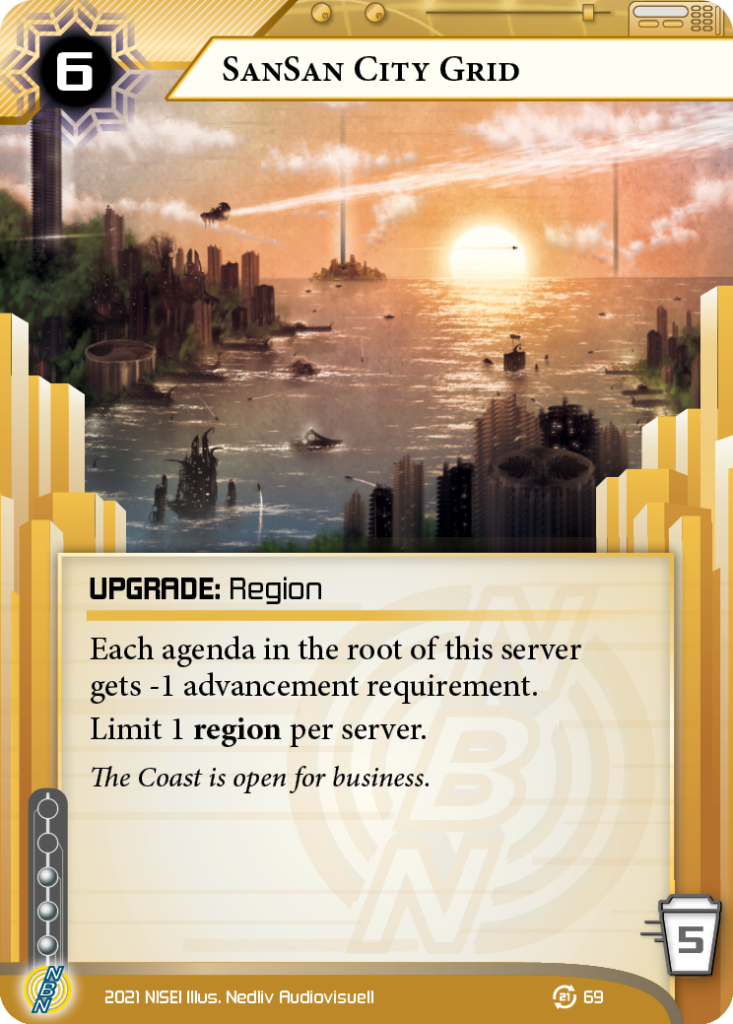
Breaking Without Breakers
Next we’re formalizing some break abilities that appear on non-icebreaker cards. Previously, the break ability on a bioroid didn’t fit into any category of abilities, and there was no explicit timing for when you could use it. Our solution to this is to make the bioroid ability a paid ability. Slight problem: an action used to be defined as a paid ability having one or more clicks in its cost, but we don’t want to classify clicking through bioroids as an action! So we have slightly changed the definition: now, an action is a paid ability whose cost begins with .
With this change, we can allow the Runner to spend clicks in the middle of a run by writing the cost as “Lose ”. We’ve got a card here to show you what the full text of a bioroid looks like in the new style. And, of course, someone else also breaks subroutines without a breaker:
Alternative Trash When?
Just like bioroids, cards such as Imp and Freedom Khumalo do not have explicit timing on when their abilities can be used. We solved bioroids by defining them as paid abilities, which you use during the window when you normally break subroutines. If Imp were to be written as a paid ability, we would run into a problem: there’s no paid ability window during the process of accessing cards. A second problem is Mumbad Virtual Tour (MVT): if there are multiple ways to trash MVT, technically you must use the first one that is available. Any solution we come up with has to present all options simultaneously. Finally, we have to work around those problems without doubling the amount of text on Imp.
The solution we settled on is adding a new paid ability window in the middle of accessing a card. This is a special window, which only allows you to use abilities like Imp and your basic ability to trash cards by paying their trash cost. These abilities are identified by a new access flag. The basic trash ability the game provides you looks like this: “Access → Pay the trash cost of the accessed card: trash the accessed card.” Full details of this change will be in the Release Notes. Let’s see this class of ability on a card!
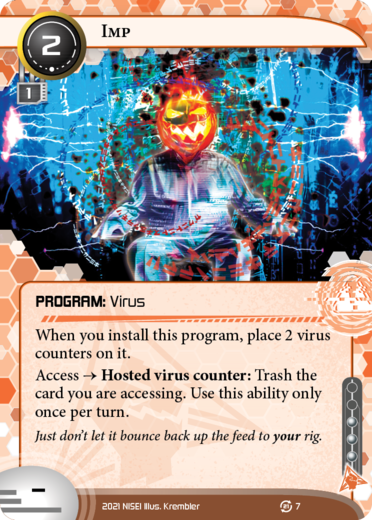
Rearrange the Run
Finally, we are solving an unintuitive situation regarding upgrades (and slightly simplifying runs while we’re at it). Several upgrades defend a server by triggering an ability when the Runner makes a successful run on the server whose root they are installed in. Consider Giordano Memorial Field, which reads: “Whenever there is a successful run on this server, end the run unless the Runner pays 2 for each agenda in his or her score area.” If a run ends because of this upgrade, the Runner still reaches the “Successful Run” trigger. The Corp can still play SEA Source on the Runner, even if the upgrade kept them out of the server. When designing upgrades, we’d rather avoid this!
What if upgrades triggered when the Runner approached the server instead? Currently, the approach server trigger is before the Corp could rez cards, such as defensive upgrades that you would really want to see this trigger. If you want to ensure that a defensive upgrade will be rezzed in time to see the “approach server” trigger, you have to rez it at the same time as the final piece of ice in front of the server! To accommodate upgrades designed around the “approach server” trigger, we are changing the structure of runs. Some things have been rearranged, but everything will function the same, with one exception: there is a paid ability window before the “approach server” trigger. The full details of this change will be in the Release Notes. There are no cards in System Update 2021 to demonstrate this change, but a few upgrades in System Gateway make use of this design! Stay tuned.
Conclusion
We’ve announced some big changes to the way some game concepts look, but the game still functions the same way. For players who love knowing the nitty-gritty details, the Release Notes will cover these topics in detail, as well as some smaller changes not mentioned here, and include a Q&A for System Gateway and System Update 2021. As previews continue, please send us questions via e-mail or Twitter. We’ll answer as many as we can in the Release Notes.
Keep an eye for the Release Notes and Comprehensive Rules 1.5 during release week!
System Gateway and System Update 2021 will be released on or shortly after March 28, 2021, as physical cards via NISEI’s print-on-demand partners and pay-what-you want files for downloading and printing at home!

